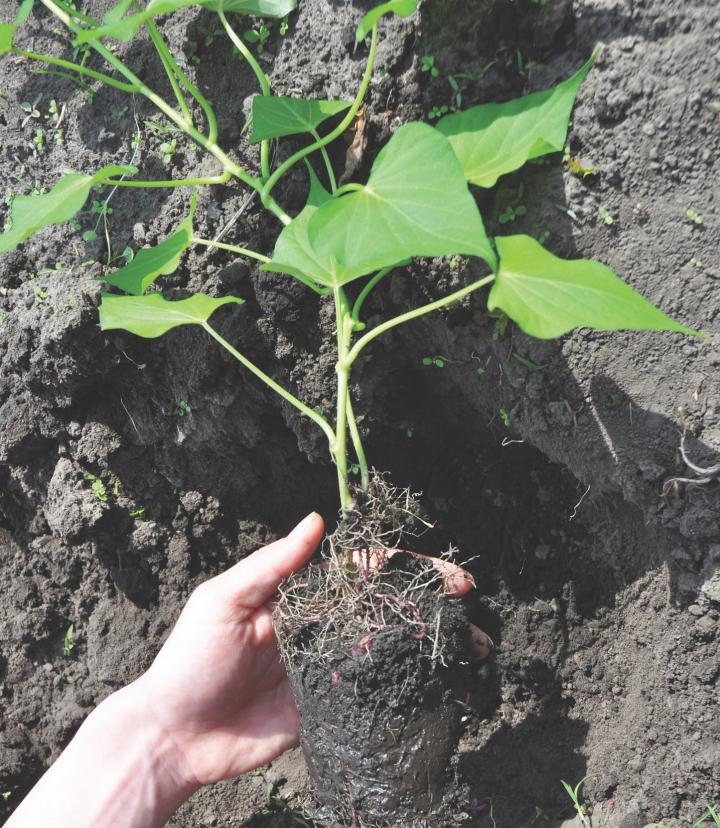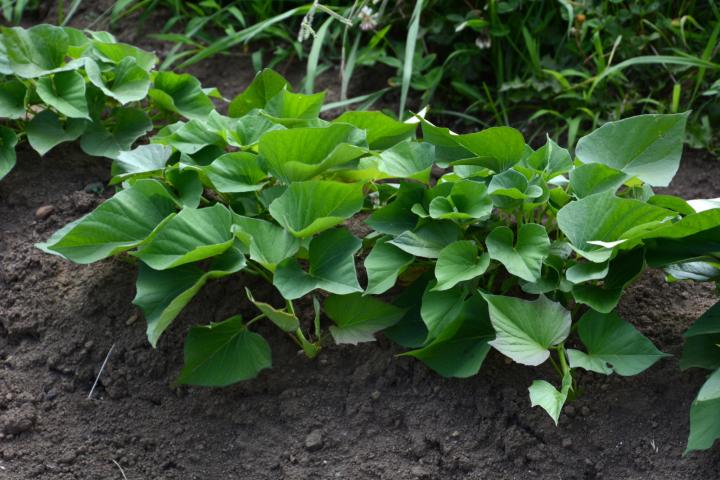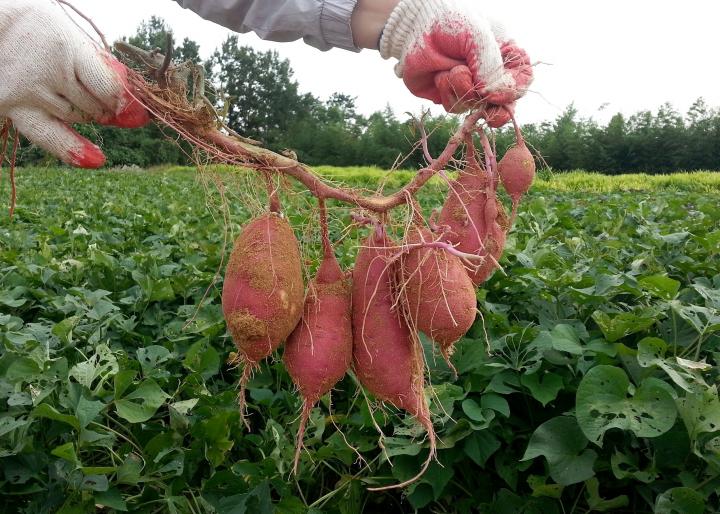
Planting, Growing, and Harvesting Sweet Potatoes
Types
The fastest-growing sweet potato varieties have orange flesh, but you might also consider varieties with white, yellow, or even purple flesh. Note that orange-flesh varieties cook up moist; white and yellow sweet potatoes become creamy; purple sweets are dry and starchy.
- ‘Beauregard’ (90 days) originally comes from Louisiana, but grows well in the North, too. It has dark red roots, dark orange flesh, and stores well.
- ‘Bush Porto Rico’ (110 days) is good for small gardens and for baking.
- ’Centennial’ (100 days) is the leading variety in the U.S. It is carrot-colored and has a good storage life; good producer for northern growers.
- ‘Georgia Jet’ (90 days) has red skin that covers moist, deep orange flesh. It is an extremely fast-growing type; good for the North.
- ‘Jewel’ (120 days) has copper-colored skin and orange flesh; disease-resistant; stores well.
- ‘Stokes’ (120 days) offers a vibrant purple color and is full of extra health benefits; cooks well in savory dishes and mashes.
- ‘Vardaman’ (110 days) is a bush type and good for small gardens; it has unique blue/purple foliage, golden skin, and reddish-orange flesh; stores well.
- ‘White Yam’ (aka ‘White Triumph’)(100 days)has white skin covering dry white flesh; one of the oldest sweet potato varieties; has compact vines.
Cooking Notes
Relatively low in calories, sweet potatoes are very nutritious, a top source of beta-carotene, and contain some protein, calcium, iron, vitamins A and C, and other minerals. They can be stored longer than winter squash.
To cook, sweet potatoes are easier than pie (or sweet potato pie!).
- They can be scrubbed, poked with a fork in a few places, and baked at 400°F for 35 minutes to 1 hour, until they give a bit when you squeeze them in your pot-holder–protected hand.
- In the microwave, a whole sweet potato baked on high should be ready in 4 to 6 minutes. It may still feel firm when done; let it stand for about 5 minutes to soften.
- Sweet potatoes can also be steamed whole (cleaned and unpeeled) for about 40 minutes or until tender or cooked whole (cleaned and unpeeled) in boiling salted water for about 35 minutes. (Boiling reduces the flavor considerably.)
- Immerse cut raw sweet potatoes in water until you’re ready to cook them; they will darken otherwise.
As a general rule, don’t substitute sweet potatoes for regular potatoes in recipes; the two aren’t related. Sweet potatoes don’t hold together the way potatoes do, and their strong flavor can overwhelm a dish meant for a milder potato taste. Sweet potatoes are also not related to yams. But they make a fine substitute for pumpkin, especially in desserts.
Check out our ten best sweet potato recipes!
I have planted sweet potatoes since April 2020 and as at yesterday 13th October, no good tubers were seen but roots that have not developed. Only one or two tubers harvested on a ridge. So, I begin to wonder of the harvest time. I did not see the leaves turn green. Could be soil be the issue becos I am not in the North, but planted at the half a plot of my residence. Grateful advuse
It’s difficult to know why your plants did not thrive. Soil? Maybe. They like a sunny spot with loamy, well-drained soil. Sweet potatoes aren’t too picky, but they do prefer soil on the sandier side, and need plenty of air space in the soil for roots to reach down. If your soil is clay, rocky, or compacted, consider raised beds. Read above and below for more possible reasons/explanations.
i just dug my sweet potatoes her in Va. I told my wife I'm going to try cutting some vines that still have roots on them and put them in a bag and freeze them for next year. I wonder if they'll grow ? What do you think ?
Sweet potato vines are tropical plants, which means that they cannot withstand cold temperatures for long. Because of this, freezing the vines will kill them, unfortunately!
It is early August in Northern Texas, and my sweet potato plant has large, healthy leaves and vines growing along the fence out of a small box in the backyard. However, I will be moving several hours South by car and will either have to transplant my plant in the car and replant it in our new home, or harvest them soon. Which is my best bet?
It sounds like the roots are in the “small box.” (You know the roots are the sweet potatoes and they are at the base of the vines under the soil, right? Just checking.) Can you take the plant with you, with the box and vines intact? If not, you can dig around in the box and see how big the roots are and decide then whether to take it altogether or harvest what you find.
Although I haven't tried this yet, I've heard that you can plant regular potatoes in old tires, stacked atop one another & filled with dirt; to minimize space I would assume.
My question is, can sweet potatoes be planted this way as well?
The idea of using old tires as planters is not something we can get behind (recommend), Sure, some sources suggest that they are safe short term (biodegradation being a long term process) and they are harmful if they have been burned or are shredded for use. It just seems that there are so many things that can be used as containers why get tires involved. In terms of growing habit, sweets do not grow like “regular” potatoes; it is not necessary to stack dirt up around sweets.
I read that vulcanised rubber contains high levels of heavy metals and other toxic compounds. I don't know whether they would definitely leach into soil and plants but I would avoid using tires for growing anything.
We planted sweet potato slips and half of them were eaten, rabbits. A few of the nibbled vines still had a slight green slip poking out of the ground. Will the slips die or continue to grow?












